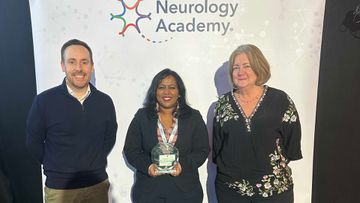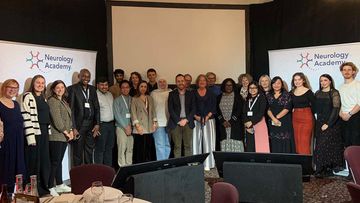CNS Immune Response in Progressive MS: Future Challenges in the Covid-19 Era: Peter A. Calebresi, MD
Event reportsReport by Denisse Bongol, MS Clinical Nurse Specialist, National Hospital for Neurology and Neurosurgery
Aims of the session
Peter Calebresi shared a series of learning objectives from the session, which were to:
- To recognise the putative mechanisms underlying disease progression in multiple sclerosis (MS),
- To describe the oligodendrocyte precursor cells and the potential for endogenous remyelination in MS
- To incorporate imaging and blood biomarkers into patient care in order to monitor disease progression
CNS pathology in MS
MS is a complex disease with multiple contributing pathophysiological mechanisms resulting in demyelination and neurodegeneration. Dr. Calabresi highlighted that gaining insight into these mechanisms can potentially lead to development of new therapies for progressive MS.
He presented the following pathological mechanisms and cited fundamental research findings:
- The peripheral immune system, involving T and B cells, mediates the autoimmune response, which underlies the proven efficacy of disease-modifying therapies (DMTs) that target and deactivate these cells.
- The glial cells in the central nervous system (CNS), that usually serve homeostatic and neuroprotective functions, can actually become neurotoxic and participate in neuronal death and demyelination as a result of chronic injury. This means that chronic inflammation may result in neurodegeneration and permanent disability.
- While clinical and radiological evidence of inflammation in MS patients strongly underpins the use of DMTs, the lack thereof in patients with progressive MS puts them into a ‘grey zone’.
- The different pathological mechanisms in the ‘non-inflammatory’ progression in MS may include: microscopic, peripheral immune-mediated damage to neurons; mitochondrial dysfunction; neurotoxic glial cells; and synaptopathy or synaptic loss.
- Disease progression and patient outcomes are very variable, and this could be associated with, for instance, environmental factors (e.g. infections, toxins, diet, gut microbiome), comorbidities (e.g. metabolic syndrome) and genetic influence.
- Progressive and chronic demyelination of the axons eventually leads to mitochondrial dysfunction or energy failure, and understanding these molecular events could allow us to intervene before it becomes irreversible.
- Pathologists from the Cleveland Clinic were able to depict the ultrastructural changes in MS axons, which include fragmented and barely detectable neurofilaments (Dutta, 2006).
- A molecule called SARM1 is activated in axonal degeneration and other variety of disease processes involving inflammation, mitochondrial dysfunction, trauma, intraocular pressure and metabolic (Krauss, 2002),
- It has become a promising research topic whether SARM1 inhibition can rescue axons in various diseases, including MS. A number of papers are also emerging showing that blocking SARM1 is protective in peripheral nerves and possibly in CNS axons as well.
- Martina Absinta et al published papers showing that 7T phase imaging technologies can be used in detecting phase rim lesions, which are associated with iron in CD68+ cells (Absinta, 2013; 2016; 2019). This suggests that persistence of phase rim lesions marks failure of early lesion repair and patients with phase rim lesions are more likely to develop disability.
- Dr. Calabresi remarked that this imaging technologies could be useful in clinical trials aimed at slowing early degeneration and facilitating lesion repair.
- Chronic inflammation causes astrocytes to become neurotoxic, and the primary substance they express is the complement component C3. This pathological process has also been observed in a variety of neurodegenerative conditions (e.g. Huntington’s disease, Alzheimer’s disease, amyotrophic lateral sclerosis and Parkinson’s disease) in response to different types of injury (Liddelow, 2017).
- Synaptic pathology is widespread in MS and it may involve deposition of complement components (C1 and C3) at synapses leading to neuron demise (Michailidou, 2015).
Oligodendrocyte progenitor cells (OPCs) and remyelination in MS
Dr. Calabresi stated that endogenous remyelination can occur in MS and pathologists were able to provide evidence of partial remyelination in about 10–20% of people with MS using myelin stain images. However, spontaneous remyelination often fails and understanding why can pave the way for therapeutic and remyelination therapies. He discussed the following principles and laboratory findings that could negatively affect remyelination:
- The OPCs derived from the neural stem cells are the precursor cells that differentiate into myelinating oligodendrocytes.
- Poor remyelination has been associated with age and this could be linked to the senescence or number of OPCs.
- The CD8+ cells may have regulatory functions in the periphery but within the central nervous system; these cytotoxic T cells are likely involved in the death of neurons and oligodendrocytes. When the OPCs are recruited to the lesion site, these cytotoxic cells seem to inhibit the remyelination process as well.
- Through a series of experiments, Dr. Calabresi and his team were able to show that endogenous remyelination fails because inflammation itself interferes with the differentiation of OPCs into myelinating cells. Also, the OPCs can activate CD8 T cells, propagating the depletion of OPCs.
Dr. Calabresi pointed out the importance of exploring the possible implications of potential COVID-19 treatments on MS DMTs. He discussed the following potential pharmacological targets for COVID-19 treatment:
- Inhibiting viral entry, replication and release through interfering with the viral receptors, the angiotensin-converting enzyme (ACE) receptors. However, there is a lack of scientific evidence to support ACE inhibitors as beneficial.
- Interfering with antigen presentation, including the use of hydroxychloroquine. However, Dr. Calabresi remarked that blocking antigen presentation could interfere with our immune systems attacking the virus, especially in the context of several viral infections
- Modulating immune responses, including the cytokine response. Dr. Calabresi highlighted the importance of understanding whether these immune responses appropriately correspond to the degree of the viral infection or whether they are excessive and inappropriate, in which case reducing them through the use of immunomodulators could be favourable without rendering the host susceptible to enhanced viral replication.
He also presented the following research findings surrounding pharmacological treatments for COVID-19:
- The preliminary findings of a randomised clinical trial involving 81 participants hospitalised with Severe Acute Respiratory Syndrome Coronavirus 2 Infection (SARS-CoV-2) showed that higher doses of chloroquine (600mg twice a day for 10 days) is associated with higher lethality and side effects compared to the low-dosage group (Borba, 2020).
- A randomised clinical trial called the Adaptive COVID-19 treatment trial involving 1063 patients studied the use of Remdesevir, which showed 31% faster recovery time and lower mortality rate compared to placebo. The results also suggested a survival benefit, with a mortality rate of 8% for the group that received Remdesevir compared to 11.6% for the placebo group (NIH, 2020).
Imaging and serum biomarkers
Dr. Calabresi explained that retinal optical coherence tomography (OCT), looking at higher-resolution images of the different layers of retinal cells, can be used in evaluating axonal degeneration following optic nerve injury. He presented the following key findings:
He cited findings from Green et al, where 79% of people with MS had evidence of ganglion layer cell dropout at post mortem (Green, 2020).
In an international MS collaborative paper that looked at the relation of retinal nerve fibre layer (RNFL) thickness and disability progression in 879 participants who had an OCT, the findings were that participants with the lowest RNFL thickness were twice as likely to have disability progression (using the Expanded Disability Status Scale [EDSS]) at year 3, and four times as likely to have disability progression at year 5 (Martinez-Lapiscina, 2016).
Dr. Calabresi reiterated that serum neurofilament light (NfL) is a biomarker of neuronal- axonal injury. He highlighted the promising use of serum NfL in evaluating not only the extent of tissue injury but also the response to immune therapies. In light of this, he presented the following meta-analysis of different phase III clinical trials including the ADVANCE and SENTINEL studies (Calebresi, 2018):
- Patients with consistently high serum NfL during year one, as measured every 3 months, are more likely to develop new T2 lesions and have greater brain atrophy through 4 years compared to patients with consistently low serum NfL.
- It was shown that there was a 15% reduction in serum NfL at 48 weeks post treatment with Pegylated Interferon beta-1α compared to placebo, where no significant reduction was seen. Furthermore, a 26% reduction in serum NfL was observed at 96 weeks post treatment with Natalizumab.
- Finally, it was also indicated that a reduction in serum NfL below 16pg/mL after 6 months in patients with initially higher serum NfL (>16pg/mL) is associated with better MRI and clinical outcomes at 2–4 years.
- Dr. Calabresi concluded with a remark that unravelling the mechanisms that underlie progressive MS allows for exploring potential targets of treatments, which could be evaluated through emerging imaging and blood biomarkers.
More information
Listen to the complete CMSC presentation from Peter Calebresi online via NeurologyLive.
References noted were:
- Dutta R, McDonough J, Yin X et al. Mitochondrial dysfunction as a cause of axonal degeneration in multiple sclerosis patients. Ann Neurol 2006; 59: 478-489.
- Krauss R, Bosanac T, Devraj R et al. Axons matter: The promise of treating neurodegenerative disorders by targeting SARM1-mediated axonal degeneration. Trends Pharmacol Sci 2002; 41(4):281-293.
- Absinta M, Sati P, Gaitan MI et al. Seven-Tesla phase imaging of acute multiple sclerosis lesions: A new window into the inflammatory process. Ann Neurol 2013; 74(5):669–678.
- Absinta M, Sati P, Schindler M et al. Persistent 7-Tesla phase rim predicts poor outcome in new multiple sclerosis patient lesions. J Clin Invest 2016; 126(7):2597–2609.
- Absinta M, Sati P, Masuzzo F et al. Association of chronic active multiple sclerosis lesions with disability in vivo. JAMA Neurol 2019; 76(12):1474–1483.
- Liddelow SA, Guttenplan KA, Clarke LE et al. Neurotoxic reactive astrocytes are induced by active microglia. Nature 2017; 541(7638):481–487.
- Michailidou I, Willems JGP, Kooi E‐J et al. Complement C 1q‐C 3–associated synaptic changes in multiple sclerosis hippocampus. Ann Neurol 2015; 77: 1007-1026.
- Borba MGS, Val FFA, Sampaio VS, et al. Effect of high vs low doses of chloroquine diphosphate as adjunctive therapy for patients hospitalized with severe acute respiratory syndrome coronavirus 2 (SARS-CoV-2) infection: A randomized clinical trial. JAMA Netw Open 2020; 3(4):e208857.
- NIH clinical trial shows Remdesivir accelerates recovery from advanced COVID-19. National Institutes of Health (NIH). Published 2020. Accessed June 16, 2020.
- Green AJ, McQuaid S, Hauser SL, Allen IV, Lyness R. Ocular pathology in multiple sclerosis: Retinal atrophy and inflammation irrespective of disease duration. Brain 2010; 133(Pt 6):1591–1601.
- Martinez-Lapiscina E, Arnow S, Wilson J et al. Retinal thickness measured with optical coherence tomography and risk of disability worsening in multiple sclerosis: a cohort study. The Lancet Neurology 2016;15(6):574-584.
- Calabresi P. Serum neurofilament light (NfL) for disease prognosis and treatment monitoring in multiple sclerosis patients: Is it ready for implementation into clinical care? Paper presented at: 34th Congress of the European Committee of Treatment and Research in Multiple Sclerosis; October 2018; Berlin, DE. Abstract 158.
This activity has been sponsored by Roche Products Limited. Roche Products Limited has had no control over the educational content of this activity.

Related articles
Encouraging excellence, developing leaders, inspiring change
MS Academy was established five years ago and in that time has accomplished a huge amount. The six different levels of specialist MS training are dedicated to case-based learning and practical application of cutting edge research. Home to national programme Raising the Bar and the fantastic workstream content it is producing, this is an exciting Academy to belong to.


